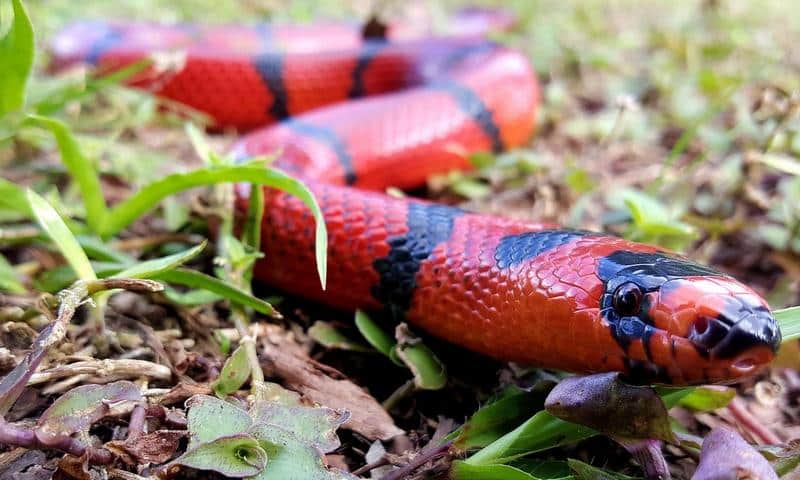Are Milk Snakes Poisonous to Dogs? [Fully Answered]
Are milk snakes poisonous to dogs? In this article, we’ll teach you everything you need to know, including an easy command that will ensure your dog’s safety around these reptiles.
We’ll also cover important things like are milk snakes venomous, can milk snakes kill a dog, where are milk snakes found, and what they look like.
Finally, we’ll help you keep your pets and property safe by instructing you on how to get rid of milk snakes without endangering your dogs. Keep reading!
Are Milk Snakes Poisonous to Dogs?

Milk snakes are not poisonous to dogs. These snakes are non-venomous and pose little to no risk to dogs or humans. However, any snake bite can cause infection or an allergic reaction, so it’s essential to monitor your dog if they interact with a milk snake.
Are Milk Snakes Venomous?
Milk snakes are non-venomous constrictor snakes. They belong to the larger family of kingsnakes, known for their immunity to the venom of other snakes. Milk snakes use their constricting ability to subdue and kill their prey, not venom. However, like any animal, they can bite when threatened or scared, but a bite from a milk snake is not venomous.
Are Milk Snakes Dangerous to Dogs?
Milk snakes are not dangerous to dogs. These snakes are typically shy and would prefer to avoid encounters with larger animals, including dogs. However, a snake, even a non-venomous one, can still bite if it feels threatened.
While a bite from a milk snake won’t inject venom, it can cause an infection or allergic reaction, and thus it is always recommended to keep an eye on your dog and prevent such interactions.
Training the “Leave It” Command
One way to help keep your dog safe from any potential harm from a milk snake or any other creature is to train your dog to respond to the “Leave It” command. Here’s a brief step-by-step guide:
- Start by holding a treat in a closed fist and present it to your dog, but don’t let them have it.
- Wait until your dog stops trying to get the treat and pulls away. Once they do, say “Leave it,” and give them a different treat from your other hand.
- Repeat this process several times, each time saying “Leave it” when your dog pulls away, and rewarding them with a different treat.
- Practice this in various scenarios and with different items, gradually increasing the difficulty until your dog can reliably respond to the command.
These steps will get your dog to stay away from milk snakes, but it’s important to remember that the underlying behavioral issues (prey drive, aggression, dominance, etc.) that were causing all of this to begin with will still be present. And until you address those, any positive changes you see are only going to be temporary.
“Well, how do I make these changes last?”
By getting your dog to truly choose to follow your direction, that’s how. I tried many times to write out how you can do that before deciding it made more sense to just link you to the free video series that explains it better than I’d ever be able to.
The series is by a man named Dan who is one of the world’s leading dog obedience trainers. In it, he teaches you how to put an end to things like when your dog bothering milk snakes and all other misbehavior using his fast and easy-to-follow methods.
In the first video, Dan will reveal to you why the two most common methods of dog training only doom you to failure. You can watch the video now by clicking here. Follow the proven system he’ll show you in his series and you’ll never have to spend another second worrying about your dog chasing milk snakes ever again!
Can Milk Snakes Kill a Dog?
Milk snakes pose very little risk to dogs. They are non-venomous constrictors that are typically not aggressive towards larger animals. While they can bite if threatened, a bite from a milk snake is unlikely to cause serious harm to a dog.
Do Milk Snakes Bite Dogs?
Milk snakes, like any animal, can bite when they feel threatened or scared. That being said, these snakes are usually quite docile and would prefer to avoid interaction with larger creatures such as dogs.
It’s always recommended that pet owners supervise their dogs when outdoors, especially in areas known to be inhabited by any type of snake. If your dog is bitten by a milk snake, it’s important to clean the wound thoroughly and monitor your pet for signs of infection or allergic reaction. Contact a vet if you notice any unusual behavior or symptoms.
Are Milk Snakes Aggressive?
Milk snakes are not aggressive animals generally. They are more likely to try and escape if they feel threatened. However, they will defend themselves if they feel cornered and have no other option, potentially biting in self-defense.
It’s important to remember that even though milk snakes are not venomous, any bite from a wild animal, including non-venomous snakes, can potentially lead to an infection if not treated properly.
Milk Snakes and Dogs: Keeping the Peace
While it’s unlikely that a milk snake could kill or seriously harm a dog, it’s always best to prevent any potential encounters. Supervise your pet while they are outdoors and keep your yard clean to deter any unwanted snake visitors.
If you live in an area where milk snakes are common, you might also consider snake-proofing your yard with fencing. And remember, teaching your dog the “leave it” command is a very useful tool in keeping them safe from all sorts of potential dangers, including encounters with snakes. Learn how to do it in the first section.
It’s important that you get this taken care of now, as it will keep your dog safe from all types of critters, not just milk snakes. You then won’t have to worry about king snakes being poisonous to dogs, corn snakes being poisonous to dogs, rat snakes being poisonous to dogs, black snakes biting dogs, copperheads biting dogs, or garter snakes being poisonous to dogs.
Where Are Milk Snakes Found?
Milk snakes are commonly found in a broad range of habitats across North and Central America. From southern Canada all the way down to northern South America, milk snakes have adapted to environments as diverse as mountain forests, grasslands, and even farmland.
What Do Milk Snakes Look Like?
Milk snakes are notable for their vibrant coloration and distinctive patterns. They display alternating bands of red, black, and white or yellow. This tricolor pattern is a source of confusion as it closely resembles the venomous coral snake.
However, milk snakes are completely harmless to humans and pets. They are medium-sized, with their length ranging from 24 to 36 inches, but some subspecies can grow up to 52 inches. They have smooth, shiny scales, a slender body, and a head slightly wider than their neck.
Where Do Milk Snakes Hide?
Given their widespread distribution, milk snakes can be found in a variety of places. In wild settings, they often seek shelter under rocks, in tree crevices, or in burrows. In more urban or suburban environments, milk snakes may hide under debris, in walls, or in old buildings, where they can hunt for rodents.
When Are Milk Snakes Most Active?
Milk snakes are primarily nocturnal, being most active during the night. They tend to be more active in warmer weather, particularly in the spring and fall. During the hottest parts of summer, milk snakes may become more crepuscular, being active at dawn and dusk, to avoid the extreme heat. In winter, they often go into a period of dormancy, similar to hibernation, called brumation.
Learn to control your dog around milk snakes by going back to the first section now.
How to Get Rid of Milk Snakes
To get rid of milk snakes, focus on eliminating what attracts them—food sources and hiding places. This involves managing rodent populations, cleaning up debris, and sealing possible entry points into your home. Always remember, though, milk snakes are non-venomous and beneficial for controlling pests.
- Manage Rodent Populations: Milk snakes are primarily attracted to places with plentiful food, which for them, means rodents. By controlling rodent populations in your home and yard, you reduce the main attraction for milk snakes. This can involve setting traps or hiring a pest control service.
- Clean Up Debris: Debris in your yard, like piles of wood, leaves, or rocks, provide perfect hiding and breeding spots for milk snakes. Regularly cleaning up and maintaining your yard can help deter them from making your property their home.
- Seal Entry Points: Look for and seal any cracks, gaps, or holes in your home’s structure, particularly near the ground. These are potential entry points for milk snakes. Regular maintenance can help ensure your home remains secure.
- Use Professional Services: If the milk snake population becomes overwhelming or if you’re uncomfortable dealing with these creatures, consider hiring a professional wildlife removal service. They have the knowledge and tools to safely and humanely relocate the snakes.
In summary, to get rid of milk snakes, you must make your property less appealing to them. This means managing food sources, cleaning up potential hiding places, and ensuring that there are no entry points into your home. If necessary, don’t hesitate to reach out to professional wildlife removal services for assistance.
Learn to keep your dog away from milk snakes (and other critters) by going back to the first section.
I’m sure you’re ready for all of this worry to be behind you, so I’ll let you get started on things now. Good luck with everything, and thanks for reading our article “Are Milk Snakes Poisonous to Dogs?”





